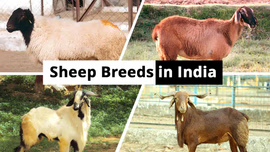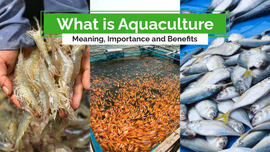Livestock Sector in India: Role, Challenges and Opportunities

The animals that are used for farming purposes and provide milk, eggs, and meat for human consumption are known as livestock. The livestock sector plays an important part in our country's economy as it contributes more than 30% to India's overall agricultural GDP. In today's blog, we will get to know the livestock sector in the Indian economy along with its types, challenges, government initiatives, opportunities and growth. So, without any further delay, let’s dive into the blog.
Table of Contents
- What is Livestock and its Types?
- Role of Livestock in the Indian Economy
- How is the Livestock Sector Beneficial for Indian Farmers?
- Major Challenges in India’s Livestock Sector
- Issues of Concern in the Livestock Sector of India
- Government Schemes and Initiatives Related to the Livestock Sector
- Opportunities for the Livestock Sector Development
- Relation between Livestock and Agricultural Growth
- Future Scope of the Livestock Sector in India
What is Livestock and its Types?
Livestock are farm animals raised and reared to produce food and non-food items such as milk, meat, hide, and wool. The different types of livestock farming in India are goat farming, sheep breed farming, dairy buffalo farming, pig farming, dairy cow farming, fish farming and poultry farming. Animal competitions such as the cock fights, ram fights, and bullfights (jalli kattu) are common during festive seasons, mostly in southern regions of India. So, people use these animals for competition and sports as well.
Role of Livestock in the Indian Economy
Livestock is important for the Indian economy as it gives various food and non-food items and many employment opportunities to farmers and fulfils their needs. In India, around 20.5 million people are dependent on the livestock sector. India has a vast number of livestock resources. Around 8.8 % of India’s population is getting employment through this sector. India is the highest owner at 535.78 million in the world. Livestock contributed 16% to the income of small farm households, against an average of 14% for all rural households. Livestock provides livelihood to two-thirds of rural communities. The livestock sector provides the following food and non-food items in the Indian economy:
- Food: The livestock sector provides various food items for humans to consume, such as milk, eggs, and meat. India is the world’s largest milk producer, with 230.58 million tonnes of milk production during 2022-23. The per-capita availability of milk is 459 grams per day. India produces nearly 138.38 billion eggs and 9.77 million tonnes of meat in a year, with a per-capita availability of 101 eggs per annum. The total fish production in India is estimated at 175.45 lakh tonnes. It is also the first in the total buffalo population in the world, with 109.85 million buffaloes.
- Animal Waste: Dung and other animal waste are considered good farm yard manure, and they have a huge value in the Indian economic market. It is also used as fuel, like biogas and dung cakes.
- Animal Fibre and Skins: Animal fibre and skin are important contributors to the Indian economy, as India produces huge amounts of animal wool, hair, hides, and pelts. India produces about 33.61 million Kg of wool, and leather is the most important product with a high potential for export.
- Carry Goods: Livestock animals are used to carry heavy goods in many rural regions, so they are completing the need for vehicles for those people.
- Bullocks: Many Indian farmers, especially in rural areas, still depend upon bullocks for various agricultural operations, even after so many agricultural advancements. The bullocks are saving a lot on fuel, which is a necessary input for using mechanical power like tractors, combine harvesters, etc.
How is the Livestock Sector Beneficial for Indian Farmers?
- Source of Income: The livestock sector is a major source of income for many farmers in India. Even after having few animals, these animals fulfil their needs. The cows and buffaloes provide income to the farmer through milk sales and sheep and goats provide income through meat, skin and wool. The animals also serve as moving banks and assets, which provide economic security to the owners.
- Food: The food provided by livestock animals, such as milk, eggs, and meat, is a rich source of protein for all the farmers as the farmers and their children also consume these food items, which adds nutritional safety to their diet and well-being.
- Employment Generation: The livestock sector creates various employment opportunities for farmers and rural people in India through activities like feeding, milking, livestock management, fodder cultivation, etc. Landless people depend on livestock to utilize their labour during the lean agricultural season.
- Livestock as an Asset: Livestock animals are assets for farmers as they can access credit, invest in farming activities, cover household expenses, and sell them in need.
- Soil Fertility: Using livestock manure as organic fertilizer nourishes and boosts soil fertility and crop yields and reduces reliance on chemical fertilizers.
Major Challenges in India’s Livestock Sector
The livestock sector plays an important role in the Indian economy, but it still faces many constraints in its development. The major challenges in the livestock sector are listed below:
- Feed and fodder scarcity.
- Lack of Healthcare and Veterinary Services.
- Low level of productivity due to improper insemination and livestock breeding.
- Different outbreaks of diseases like foot-and-mouth disease (FMD), black quarter (BQ), peste des petits ruminant (PPR) and influenza.
- Limited access to finance and credit for livestock farmers.
- Lack of awareness and adoption of modern livestock management practices.
Issues of Concern in the Livestock Sector of India
- Low Productivity: India is the largest producer of milk globally. But when it comes to productivity, it is below the world average. The milk productivity in India in 2019 stood at 1,777 kg per cow per year compared to the world average of 2,699 kg per cow (FAOSTAT).
- Structure of Livestock Population: In India, the livestock population is dominated by local breeds. There is a need for crossbred and improved breeds of livestock.
- Technological Dualism: The livestock sector in India is marred by technological dualism. For instance, dairying in urban areas is largely based on improved breeds as compared to that in rural areas.
- Non-compliance in Phyto-sanitary: Due to non-compliance with Phyto-sanitary conditions and quality standards, the exports of livestock products do not realise their true potential.
- Ineffective Quarantine Regime: This has led to the importation of contaminated biologicals and infected livestock species.
Government Schemes and Initiatives Related to the Livestock Sector
National Livestock Mission: The National Livestock Mission was implemented in 2014 with the aim of providing support for breed improvement, healthcare, fodder development, and infrastructure development.
Rashtriya Gokul Mission: This scheme was launched in December 2014 to conserve indigenous cattle breeds. This aims to increase the potential of these cattle through selective breeding and artificial insemination. It is continued under the umbrella scheme Rashtriya Pashudhan Vikas Yojana from 2021 to 2026, with a total budget of INR 2400 crore.
National Livestock Insurance Scheme: This is a centrally sponsored scheme, launched in 2005-06, with the aim of giving financial support to farmers in case of livestock losses. In this scheme, insurance coverage is provided to livestock owners against the risk of death of animals due to natural calamities, diseases, or accidents.
Animal Husbandry Infrastructure Development Fund (AHIDF): This scheme was launched under Aatma Nirbhar Bharat Abhiyan with an outlay of INR 15,000 crores. This fund aims to incentivize investments by various entities such as individual entrepreneurs, FPOs, dairy processing, value addition, and meat processing.
Opportunities for the Livestock Sector Development
Farmers have various opportunities to improve their income and livelihood through some changes in food production for livestock animals. Let’s look at past trends in food consumption patterns in India and also prospects for future growth in the demand for animal-source foods in the domestic and global markets:
Domestic Market for Animal-Source Foods
The Indian economy has seen vast growth in the last few years. The food processing industry has peformed exceptionally well with an annual growth rate of 7.3% from 2015 to 2022. India contributed 25% to global milk production, in 2022-23. The country ranked second in vegetables and fruits and egg production and fifth in meat production, respectively, in 2022-23. Apart from urban areas, the consumption of milk and milk products, as well as meat and fish, are also increased at a similar rate in rural areas. It is projected that by 2030, the demand for milk will increase to 185 metric tonnes (mt), meat to 9.3 mt, eggs to 5.8 mt, and fish to 11.2 mt.
Global Market for Animal-Source Foods and International Trade
The global market for animal source food has also been increasing day by day at a faster rate in the developing and emerging economies of Asia and South America. Having less than 1% share in global dairy exports and 3% in global meat exports, the country is exploring the possibility of exporting animal-source foods. The major livestock exports in India are buffalo meat or carabeef, which account for over 85% of the total export earnings. India is one of the major exporters of bovine meat in the whole world, with major export destinations such as Vietnam, Malaysia, Hong Kong, Saudi Arabia, UAE, and Indonesia. India’s exports of dairy products are also competitive in the international market.
Relation between Livestock and Agricultural Growth
In recent years, the livestock sector has increased compared to the overall development of agriculture and the livestock sector. The GVA from the livestock sector grew at 7.6% per annum, which is marginally higher than overall economic growth but twice the agricultural growth rate and larger than the growth rate of the dominant crop sector. The increasing demand for animal-sourced food will further increase the livestock sector in the future. Milk is the largest commodity in India, followed by meat, eggs and other non-food products such as hair, skin, dung and wool. The contribution of livestock to farm household income has also increased from 12.8% in 2012-13 to 15.5% in 2018-19. Today, the major source of income for many Indian farmers is livestock farming.
Future Scope of the Livestock Sector in India
Livestock is an essential sector of the Indian economy, providing livelihood to millions of rural populations. With the rise in demand for animal products such as meat, milk, eggs, hide, wool, etc., livestock farming has become one of the most lucrative and profitable businesses to start. The 20th Livestock Census highlights the increase in livestock population due to government emphasis on this sector. The continuous prioritisation of the government to promote livestock farming will decrease poverty in the country, create more and more employment opportunities for farmers and rural communities and lead this business to newer heights in future.
Frequently Asked Questions On Livestock Sector in India: Role, Challenges and Opportunities
1. What is livestock?
Livestock are farm animals commercially raised and reared to meet the needs of farming purposes and food (egg and meat) and non-food (wool and leather).
2. What are the advantages of livestock farming?
Livestock farming comes with many advantages. They create employment opportunities, provide food security, and alleviate poverty, in addition to raising the income of the farmers.
3. How to start livestock farming?
To start livestock farming, you need to start by selecting the type of livestock you want to rear.


Related Blogs












